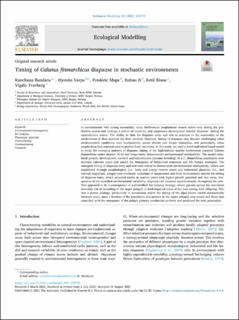| dc.description.abstract | In environments with strong seasonality, many herbivorous zooplankton remain active only during the productive season and undergo a period of inactivity and suppressed development termed ‘diapause’ during the unproductive season. The ability to time the diapause entry and exit in response to the seasonality of the environment is thus essential for their survival. However, timing of diapause may become challenging when environmental conditions vary stochastically across shorter and longer timescales, and particularly when zooplankton lack external cues to predict these variations. In this study, we used a novel individual-based model to study the emerging patterns of diapause timing of the high-latitude marine herbivorous copepod Calanus finmarchicus under shorter- (6-h) and longer-term (interannual) environmental stochasticity. The model simulated growth, development, survival and reproduction (income breeding) of a C. finmarchicus population over multiple calendar years and traced the emergence of behavioral responses and life history strategies. The emergent timing of diapause entry and exit were robust to shorter-term environmental stochasticity, which was manifested through morphological (i.e., body and energy reserve sizes) and behavioral plasticity (i.e., diel vertical migration). Longer-term stochastic variations of temperature and food environments altered the timing of diapause entry, which occurred earlier in warmer years with higher growth potential and vice versa. Irrespective of the modelled environmental variability, diapause exit occurred asynchronously throughout the year. This appeared to be a consequence of a diversified bet hedging strategy, where parents spread the starvation mortality risk of ascending to the upper pelagial at food-deprived times of the year among their offspring. This was a potent strategy, particularly in simulations where the timing of the algal bloom varied stochastically between years, since a fraction of the population was present in the upper pelagial year-round and those that coincided with the emergence of the pelagic primary production survived and produced the next generation. | en_US |

